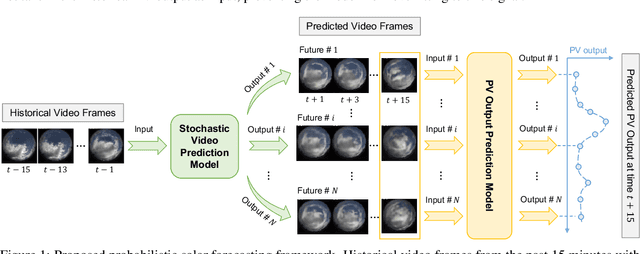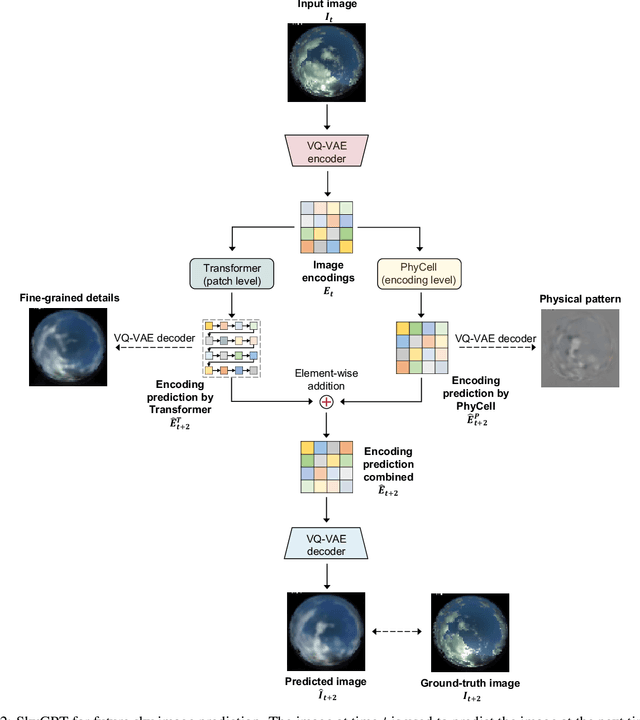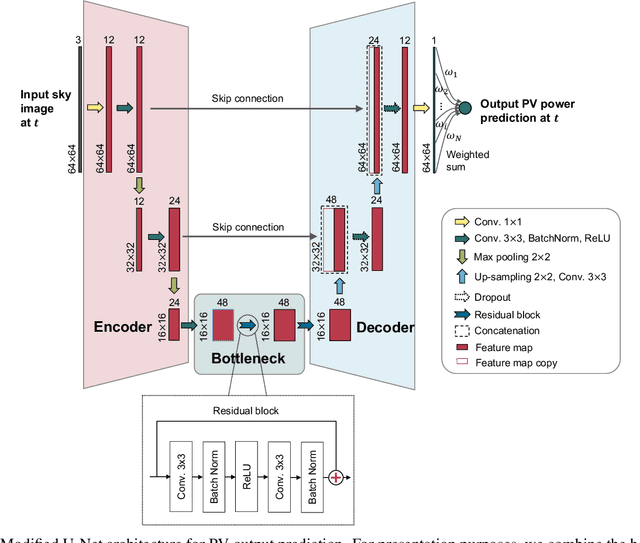Andea Scott
SkyGPT: Probabilistic Short-term Solar Forecasting Using Synthetic Sky Videos from Physics-constrained VideoGPT
Jun 20, 2023



Abstract:In recent years, deep learning-based solar forecasting using all-sky images has emerged as a promising approach for alleviating uncertainty in PV power generation. However, the stochastic nature of cloud movement remains a major challenge for accurate and reliable solar forecasting. With the recent advances in generative artificial intelligence, the synthesis of visually plausible yet diversified sky videos has potential for aiding in forecasts. In this study, we introduce \emph{SkyGPT}, a physics-informed stochastic video prediction model that is able to generate multiple possible future images of the sky with diverse cloud motion patterns, by using past sky image sequences as input. Extensive experiments and comparison with benchmark video prediction models demonstrate the effectiveness of the proposed model in capturing cloud dynamics and generating future sky images with high realism and diversity. Furthermore, we feed the generated future sky images from the video prediction models for 15-minute-ahead probabilistic solar forecasting for a 30-kW roof-top PV system, and compare it with an end-to-end deep learning baseline model SUNSET and a smart persistence model. Better PV output prediction reliability and sharpness is observed by using the predicted sky images generated with SkyGPT compared with other benchmark models, achieving a continuous ranked probability score (CRPS) of 2.81 (13\% better than SUNSET and 23\% better than smart persistence) and a Winkler score of 26.70 for the test set. Although an arbitrary number of futures can be generated from a historical sky image sequence, the results suggest that 10 future scenarios is a good choice that balances probabilistic solar forecasting performance and computational cost.
Open-Source Ground-based Sky Image Datasets for Very Short-term Solar Forecasting, Cloud Analysis and Modeling: A Comprehensive Survey
Dec 01, 2022Abstract:Sky-image-based solar forecasting using deep learning has been recognized as a promising approach in reducing the uncertainty in solar power generation. However, one of the biggest challenges is the lack of massive and diversified sky image samples. In this study, we present a comprehensive survey of open-source ground-based sky image datasets for very short-term solar forecasting (i.e., forecasting horizon less than 30 minutes), as well as related research areas which can potentially help improve solar forecasting methods, including cloud segmentation, cloud classification and cloud motion prediction. We first identify 72 open-source sky image datasets that satisfy the needs of machine/deep learning. Then a database of information about various aspects of the identified datasets is constructed. To evaluate each surveyed datasets, we further develop a multi-criteria ranking system based on 8 dimensions of the datasets which could have important impacts on usage of the data. Finally, we provide insights on the usage of these datasets for different applications. We hope this paper can provide an overview for researchers who are looking for datasets for very short-term solar forecasting and related areas.
SKIPP'D: a SKy Images and Photovoltaic Power Generation Dataset for Short-term Solar Forecasting
Jul 02, 2022



Abstract:Large-scale integration of photovoltaics (PV) into electricity grids is challenged by the intermittent nature of solar power. Sky-image-based solar forecasting using deep learning has been recognized as a promising approach to predicting the short-term fluctuations. However, there are few publicly available standardized benchmark datasets for image-based solar forecasting, which limits the comparison of different forecasting models and the exploration of forecasting methods. To fill these gaps, we introduce SKIPP'D -- a SKy Images and Photovoltaic Power Generation Dataset. The dataset contains three years (2017-2019) of quality-controlled down-sampled sky images and PV power generation data that is ready-to-use for short-term solar forecasting using deep learning. In addition, to support the flexibility in research, we provide the high resolution, high frequency sky images and PV power generation data as well as the concurrent sky video footage. We also include a code base containing data processing scripts and baseline model implementations for researchers to reproduce our previous work and accelerate their research in solar forecasting.
 Add to Chrome
Add to Chrome Add to Firefox
Add to Firefox Add to Edge
Add to Edge